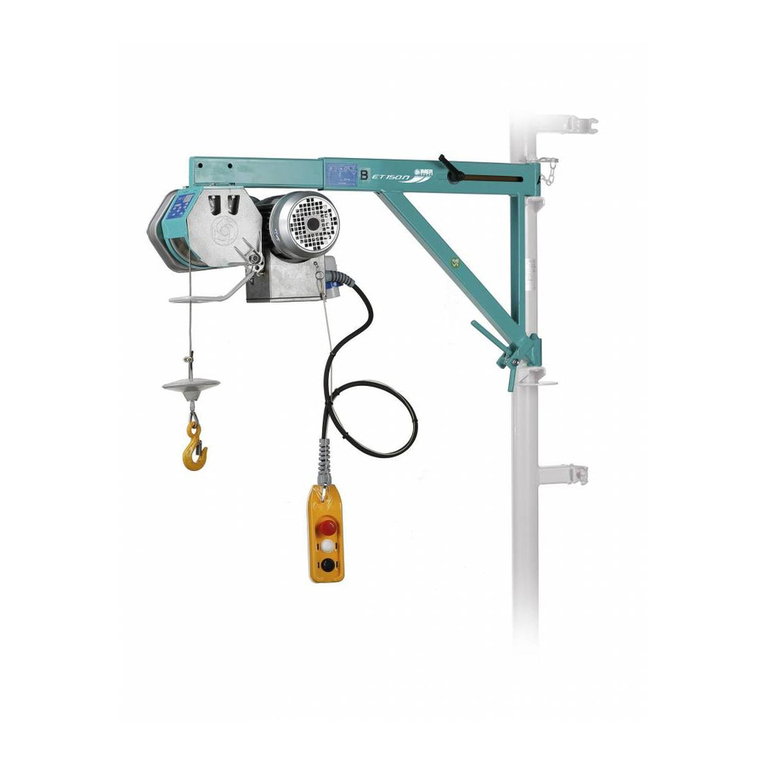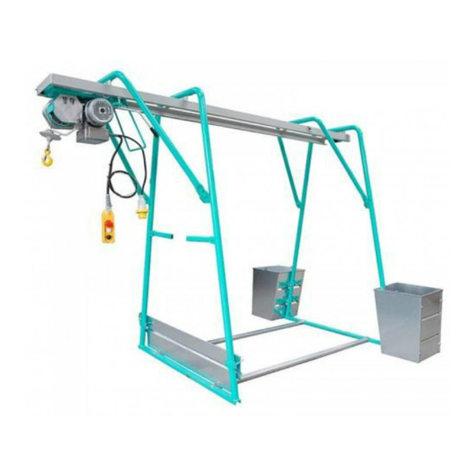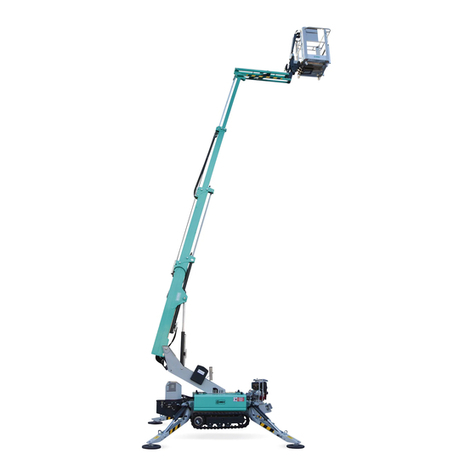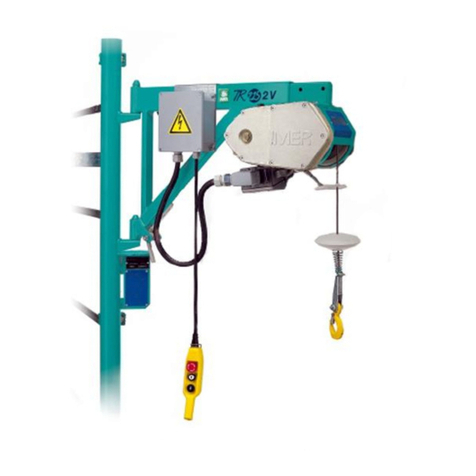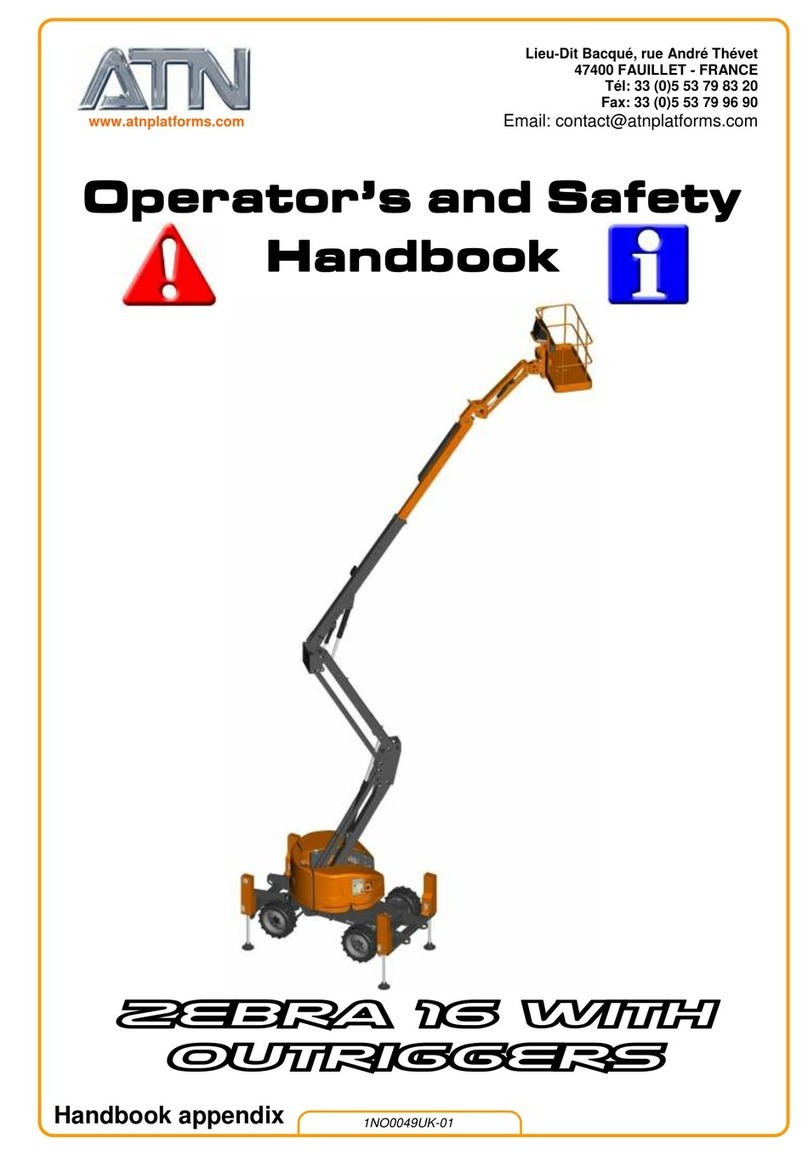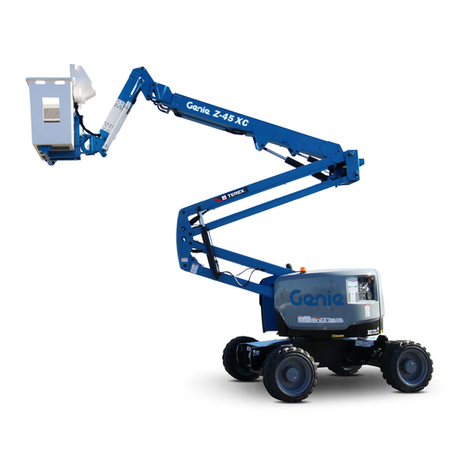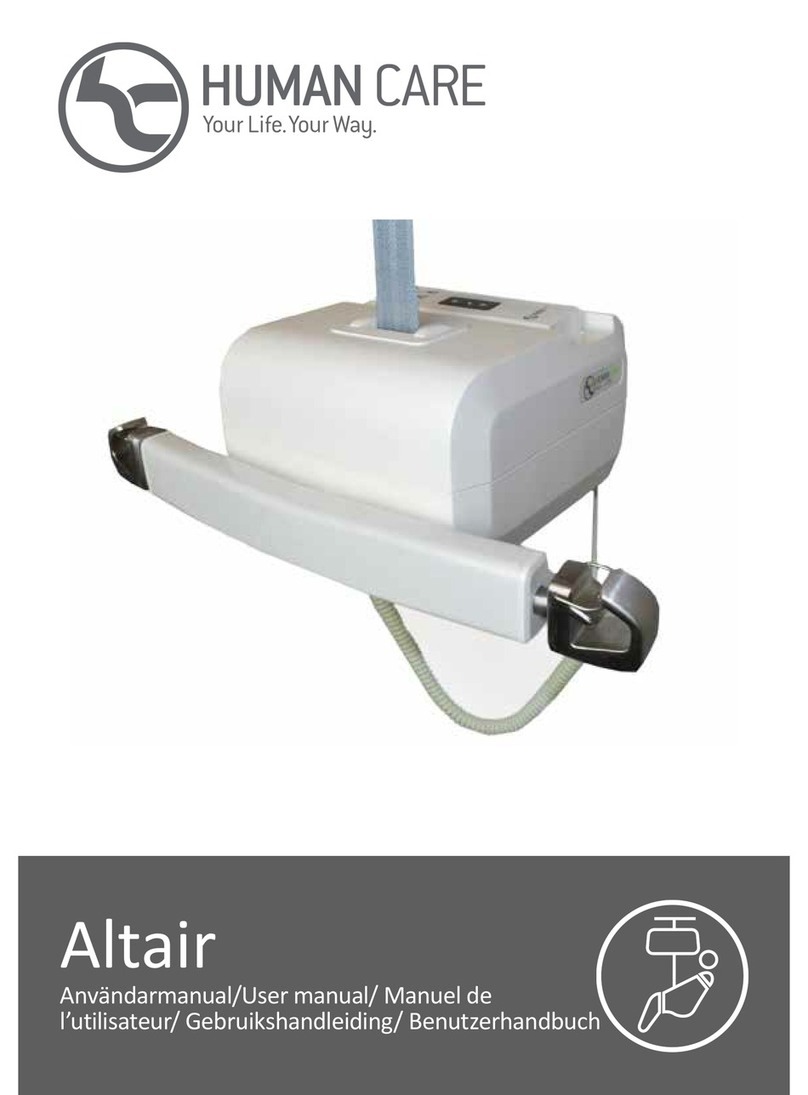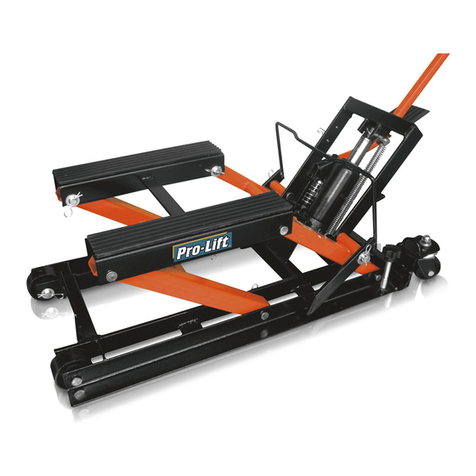IMER TR 225 Guide

R02 - 2004/01
- Cod. 3213961 -
ELEVATORE
HOIST
(1140623 - 110 V / 50 Hz - 30 m)
manuale uso manutenzione ricambi
Operating,maintenance, spare parts manual
IMER INTERNATIONAL S.p.A.
53036 POGGIBONSI (SIENA) - Loc. SALCETO
(ITALY)
Tel. +39.0577.973.41 - Fax +39.0577.983.304

TR 225 (110V 50Hz)
2
IMER INTERNATIONAL S.p.A.
Fig.1
1
FUNE ACCIAIO
2
GANCIO
3
TAMBURO
4 MOTORE ELETTRICO AUTOFRENENTE
5 QUADRO ELETTRICO
6
BRACCIO ESTENSIBILE
7
TELAIO PORTANTE GIREVOLE
8
MANIGLIA BLOCCAGGIO
9
LEVA FINECORSA SUPERIORE
10
CONTRAPPESO
11
LEVA BLOCCAGGIO BRACCIO
12
PERNO SOSTEGNO
13
COPIGLIA
14
RIDUTTORE
15
PULSANTIERA
16
LEVA FINE CORSA INFERIORE
17
INTERRUTTORE TERMICO
LIVELLA
NIVEAU
WATER LEVEL
WASSERWAAGE
NIVEL
1
ROPE
2
HOOK
3
DRUM
4
BRAKE MOTOR
5
ELECTRIC PANEL
6
EXTENDABLE ARM
7
REVOLVING FRAME
8
LOCKING HANDLE
9
LIMIT SWITCH LEVER
10
ROPE WEIGHT
11
FRAME LOCKING LEVER
12
SUPPORT HINGE
13
SPLIT PIN
14
GEAR BOX
15
PENDANT CONTROL
16
DOWN POSITION CONTROL LEVER
17
THERMAL OVERLOAD
Particolare attenzione deve essere fatta alle avvertenze contrassegnate con questo simbolo :
Special attention must be given to warnings with this symbol:
DATI TECNICI
TECHNICAL DATA
Portata max
Maxcapacity
kg
200
Velocità media di sollevamento Lifting speed
m / 1'
19
Altezza maxdi lavoro Max working height m
30
Alimentazione
Nom. voltage
V / Hz
110 / 50
Potenza motore
Motor power
Kw
0.7
Giri motore
R.P.M.
n° / 1'
1320
Assorbimento
Nom. current
A
14
Tipo di servizio Service type
S3
50 %
Livello di emissione sonora -- LwA
(EN ISO 3744)
Level of noise emission -- LwA
(EN ISO 3744)
dB
79
Livello di pressione sonora -- LpA -- 1,5 m
Level of noise pressure -- LpA -- 1,5 m
dB
<70
Peso della macchina Machine weight
kg
46
Ingombro per l'imballo Packing dimensions
mm
820x350x500
Norme di progetto
Design standards
DPR 459
del 24.7.96
S.I N°3073 of 30/11/92
FEM 1.001. UNI-ISO 4301-4308-2408 UNI 7670-9466 EN 60204-1

3
IMER INTERNATIONAL S.p.A.
TR 225 (110V 50Hz)
Caro cliente,
ci complimentiamo per il suo acquisto dell argano IMER, risultato
di anni di esperienza: è una macchina di massima affidabilità e
dotata di soluzioni tecniche innovative.
OPERARE IN SICUREZZA: É fondamentale ai fini
della sicurezza leggere attentamente le seguenti istruzioni.
Il presente manuale di USO E MANUTENZIONE deve essere cu-
stodito dal responsabile di cantiere, sempre disponibile per la con-
sultazione.
Il manuale è da considerarsi parte della macchina e deve essere
conservato per futuri riferimenti (EN 292/2) fino alla distruzione
della macchina stessa. In caso di danneggiamento o smarrimento
potrà essere richiesto al costruttore un nuovo esemplare.
Il manuale contiene importanti indicazioni sulla preparazione del
cantiere, l installazione, l uso, le modalità di manutenzione e la ri-
chiesta di parti di ricambio.
Comunque è da ritenersi indispensabile una adeguata esperienza
e conoscenza della macchina da parte del montatore e dell
utilizzatore.
Affinché siapossibilegarantire lasicurezzadell operatore,la sicu-
rezzadifunzionamentoeunalungaduratadellapparecchio,devo-
no essere rispettate le istruzioni del manuale, unitamente alle nor-
me di sicurezza e prevenzione degli infortuni sul lavoro secondo la
legislazione vigente (uso di calzature e abbigliamento adeguati, uso
di elmetti, di cinture di sicurezza, predisposizione di parapetti pro-
spicienti il vuoto, ecc.).
É vietato apportare modifiche di qualsiasi natura alla
struttura metallica o impiantistica della macchina.
IMER INTERNATIONAL declina ogni responsabilità in caso di non
osservanzadelleleggicheregolano l uso di apparecchidi solleva-
mento, in particolare: uso improprio, difetti di alimentazione, ca-
renza di manutenzione, modifiche non autorizzate, manomissioni
e/o danneggiamenti, inosservanza parziale o totale delle istruzioni
contenute in questo manuale.
1. DESCRIZIONE GENERALE
AVVERTENZA:
Operare con una macchina di solle-
vamento richiede grande attenzione e perizia, il comando può
essere affidato solo a personale esperto o che abbia ricevuto
le necessarie istruzioni.
1) La macchina è concepita per il sollevamento di
materiali e per essere utilizzata nei cantieri di costruzioni edili.
2) É vietato l uso per il sollevamento di persone e/o
di animali.
3) Non deve essere utilizzato in ambienti ove esista
il pericolo d esplosioni o incendio o in ambienti di scavi sot-
terranei.
La macchina è costituita essenzialmente da (fig.1):
- Tamburo montato sull albero del riduttore (rif.3) da unafune me-
tallica (rif.1) da un gancio di sollevamento (rif.2) e contrappeso
(rif.10).
- Motoriduttore composto da un motore elettrico autofrenante (rif.4)
e riduttore ad ingranaggi a bagno d olio (rif.14).
- Impianto elettrico (rif.5).
- Leva di comando fine corsa salita (rif.9).
- Leva di comando fine corsa discesa (rif.16.).
- Telaio portante girevole (rif.7) con braccio estensibile (rif.6) mani-
glia di bloccaggio (rif.8), leva di bloccaggio telaio (rif.11).
- Interruttore termico(17)chearresta l elevatorequandolacorren-
te supera il valore nominale (per ripristinarlo occorre schiacciarlo).
- Lelevatore dispone di 3 tipi di pulsantiere (rif. 15):
. pulsantiera da 1.5 m a comando diretto.
. pulsantiera da 25 m in bassa tensione a 24V.
. pulsantiera da 30 m in bassa tensione a 24V.
2. SUPPORTI PER L ELEVATORE
Fig.2
MAX
La struttura su cui l elevatore viene applicato deve essere in
grado di sopportare le solleci-
tazioni indicate in fig. 2, che si
generano durante il funziona-
mento.
IMER dispone di una ampia scel-
ta di supporti, rappresentati in fi-
gura 9 -10- 11 - 12 -13 -14, pre-
visti per le diverse applicazioni
di cantiere, progettati in modo da
trasmettere idoneamente alle
strutture questi carichi.
ATTENZIONE
La dichiarazione CE di conformità allegata al presente ma-
nuale, è valida solo se vengono utilizzati tutti componenti di
costruzione IMER (elevatore e supporto).
Se questa condizione non è rispettata, tale dichiarazione è
valida solo per l elevatore. Chi esegue l installazione
dell elevatore su un altro tipo di supporto dovrà compilare
una nuova dichiarazione CE di conformità, dopo aver verifi-
cato tutti i requisiti contenuti nella Direttiva Macchine 89/392/
CEE e sue successive modifiche ed integrazioni.
Le forze, indicate agli appoggi di ciascun supporto, dovranno
essere considerate nel calcolo di verifica delle strutture di
sostegno (ponteggi, terrazze, soffitti, ecc.) effettuato da tec-
nico competente.
In casodi applicazionedell elevatore suponteggio,questo
deve essere opportunamente controventato (vedere fig. 15)
Per l installazione dei diversi supporti, seguire le istruzioni di
cui ciascuno è fornito.
Nel caso si utilizzino dei supporti con portata diversa
dall elevatore,sull insieme dell apparecchioinstallato dovrà
essere affissa, ben visibile la portata ammissibile in funzione
dell elemento più critico del sistema.
2.1 PREDISPOSIZIONE DEL POSTO DI LAVORO
- Il lato dell apertura di accesso del carico al piano
deve essere protetto con un parapetto di altezza superiore a
1m ed arresto al piede.
-Accertarsi che la corsa di lavoro sia sgombra per tutta l altezza e
prendere le precauzioni necessarie perché nessuno possa spor-
gersi dai piani intermedi.
- delimitare l areadi caricoinferiore perchénessuno possasostar-
vi durante il sollevamento.
3. MONTAGGIO (Fig.1)
1)Ilmontaggiodellelevatore,cosìcomeilsuoutilizzo,richiedepersonale
esperto o che abbia ricevuto le necessarie istruzioni.
Datoilpesodellelevatore,devonoessereimpiegatiunnumerodioperatori
tali da non creare situazioni di pericolo durante il suo trasporto ed installa-
zione.
2)Laltezzamassimadilavoro(30m)èquellarelativaallaposizionedel
motoriduttore corrispondente al perno superiore del supporto.
3)Posizionareilsupportosullastrutturadelledificio,verificarelallinea-
mento verticale dei perni di sostegno (rif.12) quindi, sollevando la leva di
bloccaggio (rif.11) inserire le boccole del telaio portante (7) sui perni ed
applicare la copiglia di sicurezza (rif.13) antisfilamento.
4) Montare il braccio estensibile (6) sul telaio (7) fino alla posizione di
minima estensione, avvitare la maniglia con rondella nel foro filettato attra-
versol asolaeserrarla(rif.8).
5) Nel caso di montaggio su supporto a cavalletto, fissare il braccio
estensibile (6) al carrello mediante i fori di fissaggio previsti (rif.fig.14) uti-
lizzando viti e dadi autobloccanti. Seguire per il resto le istruzioni fornite
con il cavalletto.
6)Collegarelapulsantieraacomandodiretto(da1.5m)utilizzandolappo-
sito connettore sul quadro elettrico (5) ed inserire la sicura.
Con il comando in bassa tensione a 24V occorre fissare il quadro elettrico
sul telaio portante (7) con la staffa ed inserire il connettore al quadro (5).
Tutti i dispositivi di comando sono dotati di pulsantiera a 3 pul-
santi (fig. 3):

4
IMER INTERNATIONAL S.p.A.
TR 225 (110V 50Hz)
nero = discesa
bianco = salita
rosso = arresto in caso d emer-
genza.
7) Liberare il gancio.
4. ALLACCIAMENTO ALLA RETE ELETTRICA
- Verificare che la tensione risulti conforme ai dati di targa della
macchina.
- Verificare inoltre che la tensione di linea sia compresa tra -5% e
+5% delvalore nominale conl elevatore in funzione.
- La linea elettrica di alimentazione deve essere provvista sia di
protezione contro le sovracorrenti, sia di tipo differenziale e che il
conduttore di collegamento a terra abbia una sezione come quella
del conduttore. Il dimensionamento dei conduttori deve tener con-
to delle correnti di funzionamento e della lunghezza della linea per
evitare eccessive cadute di tensione (rif. Tab.1).
Evitare l impiego di prolunghe avvolte a spire sui tamburi.
- Il conduttore di alimentazione deve essere di tipo adatto per fre-
quenti movimenti e rivestimento resistente alla abrasione (per esem-
pio H07RN-F).
- Collegare la spina alla macchina avvitando la ghiera di ritegno
meccanico e grado di protezione IP67.
- L elevatore è così pronto per la prima manovra di collaudo.
5. ISTRUZIONI DI COLLAUDO
- Attenzione!! Questa prova deve essere fatta da
personale esperto e competente e devono essere prese le
necessarie precauzioni per la sicurezza del personale.
- Attenzione: il collaudo deve essere eseguito pri-
ma dell utilizzo dell elevatore.
Prima di iniziare il collaudo verificare accuratamente che tutta l in-
stallazione dell elevatoresia stataeseguita correttamente.
1) Estendere il braccio estensibile alla max estensione e bloccarlo
con l appositamamopola. Fardiscendere a vuotola fune, agendo
sul pulsante di discesa, fino al piano di carico inferiore, verificando
che tutta la corsa sia libera da ostacoli e che a fine corsa, sul
tamburo, restino almeno tre spire avvolte.
2) Prova di ciclo a vuoto.
Applicando un piccolo carico (20kg),
verificare il corretto funzionamento della macchina effettuando una
corsa completa di salita e discesa.
Provare i pulsanti di salita, discesa ed arresto, azionamento fine
corsa superiore e corretto avvolgimento del cavo sul tamburo,
azionamento del freno del motore elettrico.
3) Prova di carico.
Deve essere eseguita applicando il carico di
portatamassima prevista dall elevatore (200Kg).Effettuare l inte-
racorsadisalitaediscesaperverificaregliancoraggidellelevatore
e del dispositivo di frenatura del motore elettrico.
Dopo la prova deve essere verificato se nelle strutture sono pre-
senti eventuali cedimenti o assestamenti, ripetendo il controllo del-
l allineamentoorizzontaledel tamburo (usando una livellacome in
fig.1).
4)L elevatoreè provvistodi un dispositivodi sicurezzache arresta
la corsa della macchina nel punto di massima salita (rif. 9) e di
completo svolgimento del cavo (rif. 16) evitando l inversione di
avvolgimento sul tamburo.
É buona norma evitarne l intervento arrestando la macchina rila-
sciando il relativo pulsante di comando.
ATTENZIONE!!
L intervento del finecorsa di disce-
sa può avvenire o per altezza di utilizzo con conforme o per
altri problemi che possono compromettere l integrità
dell elevatore. Dopo il suo intervento è necessario un con-
trollo dell installazione e dei componenti dell elevatore (fune,
tamburo, albero, fune, ecc.).
Al termine della prova deve essere riportata la data, la verifica della
installazione e la firma sul verbale dei controlli (Tab.2) ed eventuali
osservazioni..
La procedura di collaudo indicata, completa della
prova di ciclo a vuoto 2) e carico 3), dovrà essere effettuata
ad ogni nuova installazione della macchina.
6. RACCOMANDAZIONI D USO E DI SICUREZZA
1) Non sollevare carichi superiori alla portata
dell elevatore.
2) Non permettere che nessuno rimanga sotto un
carico sospeso.
3) Non cercare di sollevare carichi collegati al suo-
lo (es. pali interrati, plinti, ecc.).
4) Assicurarsi che il carico sia ben collegato al gan-
cio dell elevatore e chiudere sempre la sicura (rif.6 fig. 4.1).
5) Se il carico per essere agganciato necessita di
accessori, questi devono essere del tipo certificato ed omo-
logato (cinghie, funi, braghe, ecc.). Dalla portata max deve
essere sottratta il peso di questi accessori.
6) Assicurarsi che non fuoriesca parte del carico
durante le fasi di sollevamento.
7) Prima di sganciare il carico, deve essere verifica-
to che sia appoggiato stabilmente.
8) Non deve essere scaricato un carico sospeso con
accessori che consentano il rilascio istantaneo o tagliando
l imbracatura.
9) Non avvicinare le mani o parti del corpo sul tam-
buro durante il funzionamento, perché potrebbero rimanere
impigliate nella fune che si avvolge causando gravi infortuni.
10) Non avvicinare le mani o parti del corpo sul con-
trappeso durante la fase di salita, perchè potrebbero subire
uno schiacciamento con la leva di finecorsa.
11) Evitare l uso della macchina in caso di condi-
zioni ambientali avverse (forte vento o temporali) in quanto il
carico non è guidato.
12) La posizione di comando e le condizioni di illu-
minazione devono consentire la perfetta visibilità del carico
per tutta la corsa di lavoro.
13) Assicurarsi che tutte le protezioni siano al loro
posto.
14) Durante l uso controllare che la fune di acciaio
si avvolga in maniera corretta, spira contro spira, senza
allentamenti o accavallamenti, che sono cause di danni alla
fune stessa. Se ciò avvenisse svolgere la fune e riavvolgere
in maniera corretta tenendola in tensione.
15) Accertarsi che la corsa di lavoro sia sgombra
da ostacoli per tutta l altezza e prendere le precauzioni ne-
cessarie perchè nessuno possa sporgersi dai piani interme-
di.
16) Delimitare l area di carico inferiore perchè nes-
suno possa sostarvi durante il sollevamento.
17) Tenere i bambini a distanza dall elevatore.
18) Quando l elevatore non viene utilizzato, non
permettete che persone estranee possono usarlo.
19) É vietato l impiego dell elevatore per trazioni
oblique (superiore a 5° rispetto alla verticale).
20) É vietato ruotare l elevatore sui perni tirandolo
per la pulsantiera: deve essere ruotato manualmente dal te-
laio.
21) Non lasciare un carico sospeso incustodito.
Sollevarlo o abbassarlo e scaricarlo.
22) Quando un carico deve essere sollevato o ab-
bassato, il comando deve essere tale da minimizzare movi-
menti pericolosi sia laterali che verticali.
23) Durante il sollevamento o abbassamento non
permettete che ilcarico cominci a ruotare: potrebbe romper-
si.
24) In caso d utilizzo del telecomando da 25m o
da 30m, il cavo della pulsantiera deve essere bloccato
alla struttura d ancoraggio per evitari probabili rottu-
re.
25) Prima di lasciare l elevatore incustodito,
togliere il carico, avvolgere completamente la fune sul
Fig.3

5
IMER INTERNATIONAL S.p.A.
TR 225 (110V 50Hz)
Fig. 4.4
Fig. 4.5
Fig. 4.3
Fig. 4.1
tamburo e quindi scollegare la presa d alimantazione
elettrica.
Ogni qualvolta si riprende il lavoro, dopo un periodo di sosta
prolungata (es. pausa notturna), è necessario verificare
l elevatore prima di iniziare il lavoro, eseguendo una prova di
ciclo a vuoto (secondo le indicazioni riportate nel punto 2, CAP.
5).
7. VERIFICHE E MANUTENZIONI
Attenzione!! Tutti gli interventi di manutenzio-
ne devono essere eseguiti dopo aver fermato la macchi-
na, tolto il carico e scollegata la presa di alimentazio-
ne elettrica.
- Le riparazioni devono essere effettuate da personale compe-
tente o nei Centri Assistenza IMER.
- Per la sostituzione di parti guaste utilizzare esclusivamente
ricambi originali.
- Controllare ogni 6/7 giorni l efficacia del fre-
no del motore elettrico.
- Mantenere sempre leggibili le scritte e le
segnalazioni sulla macchina.
- Rimuovere ogni sporcizia che si depositasse
sulla macchina.
- Mantenere sempre efficiente il funzionamen-
to del finecorsa di salita e discesa verificandoli all ini-
zio di ogni turno di lavoro.
- Assicurarsi sistematicamente dello stato del
cavo elettrico ogni qualvolta si inizia l uso della mac-
china, qualcuno inavvertitamente e/o inconsapevolmen-
te potrebbe averlo danneggiato.
7.1 FUNE D ACCIAIO
Utilizzare esclusivamente funi nuove, con caratteristiche con-
formi a quanto di seguito prescritto, dotate di attestato di con-
formità ed identificazione.
- Diametro esterno
(mm)
5
- Formazione 133 fili (19x7) antigiro
- Senso avvolgimento crociato dx
- Resistenza filo elementare (N/mm²)
1960
- Carico minima rottura fune
(kN)
16.07
- Lunghezza (m)
31
- Trattamento superficiale zincata ingrassata
- Il codice Rif. IMER è riportato nella tabella ricambi.
7.1.1 SOSTITUZIONE
DELLA FUNE (Fig.4)
La sostituzione deve essere
effettuata da un manutentore
competente.
Smontare il gancio (rif. 4) svi-
tando il bullone (rif. 5).
Smontare il morsetto (rif. 1),
spingere la zeppa (rif. 2) e
sfilare la fune dal bozzello a
cuneo (rif. 3).
Il tamburo è dotato di un dispositivo per far restare due spire di
fune completamente avvolte anche quando è completamente
svolta, per evitare di forzare il punto d attacco della fune stes-
sa.
Nella sostituzione della fune occorre montarla in modo da ri-
spettare questa condizione.
Svolgere completamente la fune. Sfilarla dall interno del tambu-
ro attraverso l apposito foro ed asola presenti.
Inserire la nuova fune nel foro e farla
uscire dall'asola del tubo del tamburo,
quindi serrare il morsetto all'estremità,
lasciando circa 1 cm di fune libera (fig.
4.2), tirare la fune finché il manicotto
arriva a contatto con la parete interna
del tamburo.
Avvolgere due spire complete mante-
nendo la fune a contatto del tamburo
(fig. 4.3).
Al
completamento della seconda
spira far passare la fune sotto il
gancio presente all interno del-
l asola del tamburo (fig. 4.4).
Tirare la fune fino ad assicurarsi il
contatto su tutta la circonferenza
del cilindro.
Avvolgere la fune disponendo cor-
rettamente spira contro spira in
stati successivi.
Infilare la fune d acciaio nel
contrappeso e nel bozzello
a cuneo (fig. 4.5).
Ripassare la fune d acciaio
nel bozzello a cuneo e nel
contrappeso.
Inserire il cuneo tra il bozzello
e la fune d acciaio.
Tirare la fune fino a stringe-
re tra di loro tutti i componenti. Quindi bloccare la fune con
morsetto ad U , facendo rimanere la parte piana a contatto
con la fune di trazione.
Procedere al montaggio del gancio sul bozzello a cuneo, bloc-
candolo con vite e dado autobloccante.
Verificare che il fine corsa di salita funzioni quando il contrap-
peso urta la leva.
Effettuare la prova di carico indicata nel paragrafo 5.
7.1.2 CONTROLLI PERIODICI
Verificare visivamente lo stato della fune gior-
nalmente od ogni qual volta si presentino sollecitazio-
ni anomale (attorcigliamenti, forti incastri nelle spire,
piegature o sfregamenti).
Sostituire la fune in presenza dei difetti indicati in fig.16.
Trimestralmente esaminare accuratamente l intera fune ed in
particolare i punti terminali registrandone il risultato nella sche-
da nel manuale Tab.2 che deve essere conservato dal respon-
sabile di cantiere.
Procedere alla sostituzione almeno ogni anno.
7.2 REGOLAZIONE DEL FRENO MOTORE (Fig. 5)
Il freno a disco ad azionamento meccanico, interviene in man-
canza dell alimentazione elettrica al dispositivo magnetico di
apertura.
In caso di riduzione della capacità frenante occorre far control-
lare dal manutentore competente l apparecchio che, se neces-
Fig. 4.2

6
IMER INTERNATIONAL S.p.A.
TR 225 (110V 50Hz)
INCONVENIENTI
CAUSE
RIMEDI
Premendo i pulsanti
di azionamento
(salita o discesa) la
macchina non
funziona.
Il pulsante di
emergenza è premuto. Disattivare il pulsante
ruotandolo.
Non arriva tensione
alla macchina. Controllare la linea.
La presa e la spina
elettrica non sono ben
collegate.
Ripristinare il corretto
collegamento.
E' intervenuto
l' interruttore di
protezione del quadro
esterno di
alimentazione.
Ripristinare il
magnetotermico.
E' intervenuto l'
interruttore termico
contro il sovraccarico
del motore.
Ripristinare premendo il
pulsante.
Interruttore termico
che interviene
frequentemente.
Tensione di linea
bassa.
Verificare i parametri
indicati nel paragrafo 4.
Scorrimento
orizzontale faticoso
della prolunga
telescopica.
La maniglia di
bloccaggio è stretta.
Allentare.
Se l' inconveniente persiste Rivolgersi all'
Assistenza IMER.
sario provvederà alla sua registrazione.
Attenzione!! Prima di intervenire sul freno as-
sicurarsi che il carico sia staccato e che la sua spina di
alimentazione elettrica sia scollegata.
Togliere il copriventola (A), regolare
il traferro (d) tra il magnete (B) ed il
disco freno (C) usando uno
spessimetro: il traferro (d) deve es-
sere 0.4 mm.
La misurazione dovrà essere effet-
tuata su tre punti diversi in modo da
verificare il parallelismo del disco fa-
cendo scivolare leggermente avan-
ti e indietro lo spessimetro.
Se il traferro è troppo grande, ridur-
lo avvitando il dado (D) con chiave
esagonale. Se il traferro è piccolo,
aumentarlo svitando il dado (D). Mi-
surare più volte la nuova distanza
(d).
Quando la distanza è stata regolata
conformemente alle dimensioni sopra elencate, riposizionare la
copertura (A).
Per controllare la tenuta dei freni, dopo aver effettuato la regi-
strazione, verificare più volte l azione frenante a pieno carico.
7.3 LUBRIFICAZIONE MOTORIDUTTORE
- Non devono esserci perdite di olio dal gruppo motoriduttore: la
presenza di vistose perdite può significare lesioni nella struttu-
ra di alluminio. In questo caso procedere immediatamente all
ermetizzazione o sostituzione del carter.
- Controllare il livello dell olio del riduttore
attraverso la spia, prima di ogni messa in opera.
Rabboccare in caso di mancanza. Cambiare l olio dopo
circa 2000 ore di lavoro. Usare olio da ingranaggi
viscosità ISO VG 460 a 40° C.
- L olio esausto è rifiuto speciale, pertanto va smal-
tito a norma di legge.
7.4 IMPIANTO ELETTRICO
Controllare l integrità della custodia isolante della pulsantiera
provvedendo alla sua sostituzione, in caso di danneggiamento
della tenuta, con ricambio originale IMER.
8. SMONTAGGIO ELEVATORE
Togliere qualsiasi carico dal gancio dell elevatore.
Avvolgere completamente la fune metallica sul tamburo.
Scollegare la presa di alimentazione elettrica. Scollegare la
pulsantiera (o il telecomando) dal quadro elettrico per mezzo
dell apposito connettore.
Svitare la maniglia di bloccaggio ed estrarre il braccio estensibile.
Togliere la copiglia sul perno di sostegno e sfilare il telaio portante
girevole.
Con il cavalletto, il carrello deve essere smontato dall elevatore
quando è stato tolto dalle guide e prima di togliere la zavorra.
9. TRASPORTO E MESSA FUORI ESERCIZIO
- Non lasciare incustodito l elevatore installato senza aver tolto
la linea di alimentazione elettrica e riavvolta la fune interamente
sul tamburo.
Lasciando inattiva la macchina per lungo tempo è buona norma
tenerla protetta dagli agenti atmosferici.
- Durante il trasporto proteggere dagli urti e dallo schiacciamento
le varie parti della macchina che possono compromettere la sua
funzionalità e resistenza meccanica
10. ROTTAMAZIONE DELL ELEVATORE
Per la rottamazione dell elevatore, al termine della sua vita ope-
rativa, occorre seguire almeno le seguenti fasi:
a) scaricare l olio utilizzando l apposito tappo;
b) separare i vari componenti plastici ed elettrici (cavi,
pulsantiera, ecc.);
c) suddividere i componenti metallici per tipo di metallo (acciaio,
alluminio, ecc.);
Una volta così suddiviso, smaltire i vari componenti utilizzando
centri di raccolta autorizzati.
Non disperdere nell ambiente, possono causare in-
cidenti od inquinamento.
11. INCONVENIENTI / CAUSE / RIMEDI
12. IN CASO DI GUASTO DELLA MACCHINA CON
CARICO SOSPESO
- Se possibile, rimuovere il carico accedendo dal livello in cui si
trova, quinditogliere l elevatore eprovvederealla sua manutenzio-
ne.
- Altrimenti utilizzare un altro apparecchio di sollevamento (di por-
tata sufficiente)posto più in alto, sospenderel apparecchio guasto
sia nella zona del carico che vicino agli attacchi.
Sollevarlo lentamente in modo da liberarlo dagli attacchi, quindi
calare tutto a terra.
- Non tentare di agire sul dado di regolazione del freno perchè
sfuggirebbe.
- Non cercare di riparare il guasto intervenendo sulla macchina
con carico sospeso.
13. LIVELLO DI RUMOROSITA
ALL
ORECCHIO
DELL
OPERAT
ORE
Il livello Lp(A) indicato nella tabella DATI TECNICI corrisponde al
livello equivalente ponderato di pressione sonora in scala A previ-
sto dalla 98/37/CE. Tale livello è misurato a vuoto, alla testa del-
loperatore in posizione di lavoro a 1,5 metri dallapparecchio, con-
siderando le diverse condizioni di lavoro.
Fig. 5

7
IMER INTERNATIONAL S.p.A.
TR 225 (110V 50Hz)
Fig.2
MAX
Fig.3
Dear Client
Congratulations on choosing the IMER hoist, the reliable and
innovative result of years of experience.
WORKING IN SAFETY
To work in complete safety, read the following instructions
carefully before installing the hoist.
This operation and maintenance manual must be kept on site by
the person in charge, e.g. the site foreman, and must always be
available for consultation.
The manual is to be considered an integral part of the machine and
must be kept for future reference (EN 292/2) until the machine is
disposed of. If it is damaged or lost, a replacement copy may be
requested from the hoist manufacturer.
The manual contains important information regarding site
preparation, installation, operation, maintenance, and ordering of
spare parts. Nevertheless, the installer and the operator must both
have adequate experience and knowledge of the machine prior to
use.
To guarantee the complete safety of the operator, safe operation
and long life of equipment, follow the instructions in this manual
carefully, and observe all safety standards currently in force for the
prevention of accidents at work with particular reference to
suspended loads and fall equipment (use of suitable footwear and
clothing, hard hats, safety harnesses, proper installation of railings
around drops, etc.).
It is strictly forbidden to carry out any form of
modification to the steel structure or working parts of the
machine.
IMER INTERNATIONAL declines all responsibility for non-
compliance with laws and standards governing the use of lifting
equipment, in particular; unprogrammed use, defective power
supply, lack of maintenance, unauthorised modifications, tampering
with or damage to part or all of the equipment, and partial or total
failure to observe the instructions contained in this manual.
1. GENERAL DESCRIPTION
ATTENTION
: Use of lifting equipment requires care
and skill. The machine must be operated by skilled and
properly instructed personnel only.
1) The machine is designed to lift materials only and
for use on building construction sites.
2) Carrying passengers and/or animals is prohibited.
3) The machine must not be used in potentially
explosive atmospheres or underground.
The machine consists of (fig. 1):
Drum type winch fitted to reduction gear shaft (3), wire rope (1),
lift hook (2) and counterweight (10).
Gearmotor consisting of an electric brake motor (4) and oil bath
reduction gear unit (14).
Electrical system (5).
UP position control lever (9).
DOWN position control lever (16).
Rotary frame (7) with telescopic arm (6), loocking handle (8) and
frame locking lever (11).
Thermal overload (17) which stops the winch when the current
exceeds the nominal value (press to reset).
The winch has two types of pendant control (15)
1.5 m lead direct pendant
25 m low voltage (24V) pendant.
30 m low voltage (24V) pendant.
2. WINCH SUPPORTS
The structure supporting the
winch must withstand the loads
generated during operation (Fig.
2). IMER offers a wide range of
supports (see figures 9-10-11-
12-13-14) for use on building
sites, designed to suitably
transfer the loads to the building
structures.
WARNING
The EC Declaration of Conformity enclosed with this manual
is only valid if only IMER components are used for the winch
and support.
If this condition is not complied with, the Declaration is
applicable to the winch only. The installation technician who
fits the winch an another type of support must compile a new
EC Declaration of Conformity after having satisfied all the
provisions of the Machinery Safety Directive 89/392/EEC and
its subsequent modifications and supplements.
These forces - referred to support couplings - must be accounted
for in calculations related to supporting structures (scaffolding,
balconies, ceilings, etc.), made by a qualified technician.
If the winch is to be secured to scaffolding, never fit it to a free
standing upright (Fig. 15).
To install the various supports, follow the instructions applying to
each assembly.
When using supports with load bearing capacities other than that
of the hoist, the permissible load bearing capacity of the weakest
element of the system must be prominently displayed.
2.1 INSTALLING THE HOIST ON SITE
- The load access to the floor must be protected by
a rail over 1m high and a foot stop.
- Make sure that the lifting run is free from obstacles, and ensure
that nobody can lean out into the hoistway from intermediate floors.
- Cordon off the ground loading area to prevent interference with
work.
3.ASSEMBLY (Fig.1)
1) Only competent, trained personnel may assemble and operate
the hoist.
Given the weight of the hoist, an appropriate number of personnel
must be used for handling and installing it so as to avoid hazardous
situations.
2) The maximum working height (30m) corresponds to the
gearmotor position i.e. is measured from the top hinge of the
support.
3) Secure the support to the building and check the support pins
vertical alignment (12); then lift the locking lever (11) to insert the
frame bushings (7) onto the pins and fit the split pin retainer (13).
4) Fit the telescopic arm (6) to the frame (7) at its minimum
extension, screw on the locking handle and washer in the threaded
hole through its slot and tighten fully.
5) When assembling on a trestle support, fit the telescopic arm (6)
to the carriage through the securing holes (14) using bolts and
locknuts. For the rest, follow the instructions for the trestle support.
6) Insert the direct pendant control (1.5 m lead) plug in the electrical
panel (5) and turn on the main switch
For the 24V low voltage pendant fix the electrical panel on the fra-
me (7) and insert the connector in the panel (5).
All pendant controls have 3 pushbuttons (Fig. 3):
black: down
white: up
red: emergency stop.
7) Release the hook.
4. CONNECTION TO THE MAINS
- Make sure that the mains voltage is the same as that specified on
the dataplate.
- Also check that the mains voltage is within the range -5% to +5%
of the nominal operating value.
- The power cable must be fitted with an overload circuit breaker or
fuse and a RCCD, the earth wire must have the same cross-section
as the power cable.
The conductors must be dimensioned in proportion to both the
operating current and their length to avoid voltage drops (Table 1).
Do not use extension leads wound on drums. Make sure that any
extension cable connections are dry and safe.
- The power cable must be suitable for frequent handling and have
an abrasion-resistant sleeve (for example H07RN-F).
- Insert the plug into the machine and tighten the securing collar
(IP67 protection).
- The hoist is now ready for testing.

8
IMER INTERNATIONAL S.p.A.
TR 225 (110V 50Hz)
5. TESTING
- Warning! Testing must be carried out by qualified
personnel. Take all necessary precautions to ensure perso-
nal safety.
- Warning! The winch must be tested before use.
Before testing the hoist make sure that it has been correctly
installed.
1) Extend the jib to its maximum and lock into position. Using the
down botton lower the hook (without load) to the bottom of the
hoistway and make sure that it is clear of obstructions and at least
three turns of rope remain on the drum.
2) No-load test.
Load the hoist with 20 Kg and check the correct
operation of the hoist by raising and lowering the load through its
entire run once (checking the correct operation of up and down
bottons, stop button, UP limit switch operation and the correct
winding of the rope on the drum. Check the operation of the brake.
3) Load test.Load the hoist with its maximum admissible load
(200 Kg). Lift and lower the hoist through its entire run to test the
support structures and brake.
Following the test, check the security of the mountings and
supports. Check again the horizontal alignment of the hoist with a
spirit level.
4) The hoist is fitted with a safety which stops travel at the UP (9)
and fully unwound positions (16) to avoid the rope winding on in
the wrong direction.
Do not depend on this safety to stop the winch; release the control
button to stop the winch instead.
IMPORTANT!!
Down limit switch (16) activation can
occur either due to incorrect working height or due to other
problems which may prejudice correct hoist functioning. After
the limit switch has been activated, the hoist installation and
components must be checked (rope, drum, shaft etc.)
If satisfied with the test results complete the entry in the site register
(Tab. 2).
In case of new installations and after every service,
repeat the no-load (2) and load (3) tests described above.
6. SAFETY WARNINGSAND OPERATING PRECAUTIONS
1) Do not lift weights in excess of the maximum
admissible load.
2) Do not allow anyone to stand under a load.
3) Never attemps to lift loads attached to the ground
(e.g. embedded poles, plinths, ect.).
4) Make sure that the load is always well secured to
the hook and close the safety catch (Fig. 4.1 ref. 6).
5) If accessories are required for lifting, ensure that
they are certified and approved (belts, ropes, slings etc.).
Subtract the weight of accessories from the maximum load
capacity.
6) Ensure that no load spillage occurs during lif-
ting.
7) Ensure complete load stability before unhooking
the load.
8) Never unload a suspended load with accessories
that cause immediate release and never cut slings to remove
the load.
9) Keep hands and other parts of the body well clear
of the drum during operation to avoid getting caught in the
winding rope and seriously injured.
10) Keep hands and other parts of the body well
clear of the counterweight during lifting to avoid crushing
against the stop lever.
11) Do not use the machine in bad weather (strong
wind or storms) as the load is not guided.
12) The entire lifting run and the load itself
must be visible from the operating position and
adequately illuminated.
13) Ensure that all the guards are in place.
14) Check that the rope winds on correctly, one turn
at a time without slack or overlay which might damage the
rope itself. If it is not correctly wound on, unwind the rope
and rewind it correctly under tension.
15) Make sure that lifting run is free from obstacles,
and be sure that nobody can lean forward on intermediate
floors.
16) Enclose ground loading area to prevent people
from interfering with work.
17) Do not allow children access to the hoist.
18) When the hoist is not being used, do not allow
unauthorised persons access to it.
19) The hoist may not be used for pulling loads
obliquely (exceeding 5° with respect to vertical lifting).
20) Do not pull on the pendant control to turn the
hoist; use the frame for this purpose, turning it by hand.
21) Do not leave a suspended load unattended. Lift
it or lower it and off load it.
22) When lifting or lowering a load use a smooth
action to minimise dangerous vertical or sideways
movements of the load.
23) Do not allow loads to spin while lifting or
lowering. The cable could be dameged.
24) With 25m or 30m low voltage pendant:
fasten the cable to the structure,otherwise it could bre-
ak.
25) Lower and stop the hoist, remove the load, wind
the rope completely onto the drum and then unplug before
leaving the hoist unattended.
When operation is resumed after a lengthy period of disuse the
entire machine must be tested under no-load conditions before
starting, as described above (point 2, CAP.5).
7. TESTINGAND MAINTENANCE
Warning!! Only carry out maintenance with the
machine switched off, unloaded and disconnected from the
mains.
- Repairs must be done by qualified personnel or by IMER Technical
Service.
- Use only IMER original spare parts.
- Check the motor brake every 6/7 days.
- Ensure that the notices and inscriptions on the
machine are prominently displayed and legible.
- Keep the machine clean of dirt.
- Check the operation of the UP and DOWN position
limit switches at the start of each work shift.
- Check the electrical cable at the start of every work
cycle for accidental damage.

9
IMER INTERNATIONAL S.p.A.
TR 225 (110V 50Hz)
Fig. 5
7.1 WIRE ROPE
Only use new ropes as specified below, complete with certificate
of conformity and identification.
External diameter (mm)
5
Type
133 wires (19x7) anti-spin
Direction of lay
dx
Strand strength
(N/mm2)
1960
Minimum breaking strain
(kN)
16.07
Length
(m)
31
Surface treatment
galvanised, greased
The IMER reference code is given in the spare parts table.
7.1.1 REPLACING THE
ROPE (Fig. 4)
The rope must be replaced by
a qualified service technician.
Remove the hook (4) by
unscrewing bolt (5).
Remove the clamp (1), push on
the wedge (2) and extract the
rope from the block (3).
The drum is fitted with a device which
ensures that 2 turns of rope are always
wound on even when the rope is
unwound to its limit. This stops the rope
attachment from being over-forced.
The rope must be attached in this way.
Completely unwind the rope. Extract
from the inside of the drum through the hole and slot.
Insert the new rope in the hole ahd thread it through the slot in
the drum tube. Tighten the clamp at the end, leaving about 1 cm
of rope free (Fig. 4.2), and pull the rope until the clamp comes
in contact with the innner wall of the drum.
Wind on two complete turns keeping
the rope in contact with the drum
(Fig. 4.3).
On the second turn pass
the rope under the hook
inside the drum slot (Fig.
4.4).
Tension the rope for good
contact with the drum
surface.
Now wind on the rope in
adjacent turns, one layer at a time.
Insert the wire rope into the counterweight and the block (Fig.
4.5).
Pass the rope back through the counterweight and the block.
Insert the wedge between the block and the rope.
Pull the rope to tighten all components. Now lock the rope with a
U-clamp so that the flat part remains in contact with the lifting section
of the rope.
Fit the hook to the block and tighten the bolt and locknut.
C
heck that the UP limit switch operates when the counterweight
touches the lever.
Run the load test described in paragraph 5.
7.1.2 PERIODIC CHECKS
Visually check the condition of the rope every
day and whenever it is subjected to abnormal strain
(twisting, bending, kinks or abrasion).
Replace the rope when defective (Fig. 16).
Inspect the entire rope carefully every three months and in
particular the ends; note the results in the chart (Table 2) which
must be kept by the site foreman.
Replace the rope at least once a year.
7.2 ADJUSTING THE MOTOR BRAKE (Fig.5)
The brake is of the no-power engagement type.
If its braking power is reduced a
qualified technician must check the
device and adjust it.
Warning!! Before
servicing the brake make sure
that the winch is not loaded and
that the brake s power supply is
disconnected.
Remove fan cover (A), and adjust the
air gap d between magnet (B) and
brake disk (C) by means of a feeler
gauge.
The gap (d) must be 0.4 mm.
Measurement should be taken at three
points in order to check that the disc
is perfectly parallel to the magnet.
Slide the feeler gauge lightly backwards and forwards. If the
air gap is too wide, reduce it by tightening nut D with a ring
spanner. Check distance d several times. If the air gap is too
small, increase the it by unscrewing nut D .
Once the air gap has been correctly adjusted, refit cover A .
To check braking power, after carrying out the adjustment,
repeatedly test braking action under full load conditions (ref.
para. 5).
7.3 GEARMOTOR LUBRICATION
- The gearmotor unit must not develop oil leaks. Leaks may
indicate damage to the aluminium casing. In this case, reseal or
replace the casing.
- Check the gearmotor oil level through the
sight glass before every start up or long storage. Refill
as required. The oil should be changed every 2000 hours.
Use gear oil with ISO VG 460 viscosity at 40°C.
- Used oil is classed as special waste. As such, it
must be disposed of in accordance with the established
legislation.
7.4 ELECTRICAL SYSTEM
Check the condition of the pendant control case and cable , if
damaged it should be replaced with the IMER spare part.
Fig. 4.3
Fig. 4.4
Fig. 4.1
Fig. 4.5
Fig. 4.2

10
IMER INTERNATIONAL S.p.A.
TR 225 (110V 50Hz)
8. DISMANTLING
Unload the hook.
Wind the wire rope completely onto the drum. Disconnect the
machine from the mains. Disconnect the pendant control (or
remote control) from the electrical panel.
Unscrew the locking handle and extract the telescopic arm.
Remove the split pin on the support pin and extract the revolving
frame.
If a trestle is being used, the hoist unit must be removed from the
carriage after it has been removed from the beam.
9. TRANSPORTAND STORAGE
- Do not leave the installed hoist unattended without having first
wound the rope completely onto the drum and disconnected the
electrical power supply.
When storing the machine for a long period of time, protect it from
weather conditions.
- During transport, protect the machine from blows and crushing to
avoid compromising its functionality and mechanical strength.
10. SCRAPPING
In case of scrapping, proceed as follows:
a) drain off all oil by means of the relative oil plug;
b) separate all plastic and electrical components (cables,
pendant control, ect.);
c) divide all metal components according to type (steel,
aluminium, ect.).
On completion of the above, dispose of all components at authorised
waste disposal centres, in compliance with current legislation.
Respect the environment: certain parts can be
harmful to persons or the environment.
11. TROUBLESHOOTING
12 . PROCEDURE IN CASE OF FAULT WITH LOAD
SUSPENDED
- If possible remove the load from the nearest level, then
dismantle the hoist and service it.
- If this is not possible, use another lifting machine (with adequate
load bearing capacity) from higher up and suspend the faulty hoist
both at the load and at the hoist attachment point.
Remove the split pin and lift the faulty hoist slowly off its fitting,
then lower the entire load to the ground.
- DO NOT adjust the motor brake with the load suspended as it
would be uncontrollable.
- DO NOT try to service the machine with the load suspended.
13. NOISE LEVEL AT THE OPERATOR S EAR
The level Lp(A) given in the TECHNICAL DATA chart
corresponds to the weighted equivalent sound pressure level
on scale A of European Directive 98/37. This level is measured
with no load, at the operator s head in the working position 1.5
metres away from the instrument, considering the different
working conditions.
FAULT
CAUSE
SOLUTION
The machine does
not lift or lower on
command
Emergency stop button
engaged
Turn to disengage
No power to machine
Check mains cable
Plug not inserted
Insert the plug
Power board cutout
tripped
Reset the overload trip
Thermal overload
switch tripped
Reset by pushing the
button
Thermal cutout trips
frequently
Low mains voltage
Check the parameters in
Paragraph 4
Difficult to lengthen
the telescopic arm
Lock knob too tight
Slacken
IF THE FAULT PERSISTSContact IMER
Technical Service
Contact IMER Technical
Service
WARNING!
Additional measures shall be taken to
prevent any person falling or any person
being struck by falling object, according
to the relevant regulations in the country
of use.

TR 225 (110V 50Hz)
11
IMER INTERNATIONAL S.p.A.
SCHEMA ELETTRICO - WIRING DIAGRAM
Fig.8
110 V
Fig.7
Fig.6
I
QUADRO (FIG.8)
PE
CONDUTTORE DI PROTEZIONE
L1
CONDUTTORE DI LINEA FASE
N CONDUTTORE DI LINEANEUTRO
F1
INTERRUTTORE TERMICO
S4
FINECORSA DISCESA
S5
FINECORSASALITA
X1
CONNETTORE COMANDI
X3
MORSETTI MAGNETE
X4
CONNETTORE CONDENSATORE
X5
CONNETTORE MOTORE
X6
CONNETTORE ALIMENTATORE MAGNETE
S
ALIMENTATORE MAGNETE
AS
AVVOLGIMENTO MOTORE SALITA
AD
AVVOLGIMENTO MOTORE DISCESA
AM
AVVOLGIMENTO MAGNETE FRENO
TELECOMANDO (FIG.6)
L1
CONDUTTORE DI LINEA
N CONDUTTORE DI LINEANEUTRO
PE
CONDUTTORE DI PROTEZIONE
T1
TRASFORMATORE
X1
CONNETTORE
X2
MORSETTIERA
F2
FUSIBILE TRASF. (INGRESSO)
F3
FUSIBILE TRASF. (USCITA)
K1
RELE' ARRESTO
K2
RELE' DISCESA
K3
RELE' SALITA
S1
PULSANTE ARRESTO
S2
PULSANTE DISCESA
S3
PULSANTE SALITA
PULSANTIERA (FIG.7)
S1
PULSANTE ARRESTO
S2
PULSANTE SALITA
S3
PULSANTE DISCESA
X1
CONNETTORE COMANDI
GB
SWITCHBOARD (FIG.8)
PE
EAR
TH WIRE
L1
LIVE WIRE
N
NEUTRAL WIRE
F1
THERMAL OVERLOAD
S4
DOWN LIMIT SWITCH
S5
UP LIMIT SWITCH
X1
PENDANT
CONTROL
CONNECT
OR
X3
MAGNET
TERMINALS
X4
CAP
ACIT
OR CONNECT
OR
X5
MOT
OR CONNECT
OR
X6
MAGNET
POWERING CONNECT
OR
S BRAKE RECTIFIER
AS
MOT
OR WINDING, UP
AD
MOT
OR WINDING, DOWN
AM
BRAKE MAGNET WINDING
CONTROL BOARD (FIG.7)
S1
ST
OP
BUTTON
S2
UP
BUTT
ON
S3
DOWN BUTT
ON
X1
PENDANT CONTROL PLUG
REMOTE CONTROL (FIG.6)
L1
LIVE WIRE
N
NEUTRAL WIRE
PE
EAR
TH WIRE
T1
TRANSFORMER
X1
CONTROL
CONNECT
OR
X2
SWITCHBOARD
TERMINALS
F2
TRANSFORMER. FUSE
F3
AUXILIARY TRANSFORMER. FUSE
K1
ST
OP
CONT
ACTOR
K2
UP
CONT
ACT
OR
K3
DOWN CONT
ACT
OR
S1
ST
OP
BUTTON
S2
UP
BUTT
ON
S3
DOWN BUTT
ON

TR 225 (110V 50Hz)
12
IMER INTERNATIONAL S.p.A.
PUNTELLO PER INTERNI
POTEAU POUR INTERIEUR
HOIST FRAME FOR INTERMEDIARY FLOORS
INNENSTÜTZE
PUNTAL PARA INTERIORES
ELEVATORE
APPAREIL DE LAVAGE
HOIST
AUFZUG
ELEVADOR
TRAVE
POUTRE
BEAM
TRÄGER
VIGA
PARAPETTO
PARAPET
PARAPET
BRÜSTUNG
PARAPETO
TRAVE
POUTRE
BEAM
TRÄGER
VIGA
LIVELLA
NIVEAU
SPIRIT LEVEL
WASSERWAAGE
NIVEL
ZONA LAVORO OPERATORE
ZONE DE TRAVAIL OPÉRATEUR
OPERATOR WORK ZONE
ARBEITSBEREICH DES
BEDIENERS
ZONA DETRABAJO OPERADOR
POSIZIONE APPOGGIO SUPERIORE
POSITION D'APPUI SUPÈRIEURE
POSITIONING TOP FOOTANORDNUNG
DER OBEREN AUFLAGE
POSICION APOYO SUPERIOR
KIT PER PUNTELLO DA ESTERNI
KIT POUR POTEAU D' EXTERIEUR
HOIST FRAME FOR ROOFS
BAUSATZ AUßENSTÜTZE
KIT PARA PUNTAL DE EXTERIORES
LIVELLA
NIVEAU
SPIRIT LEVEL
WASSERWAAGE
NIVEL
CONTENITORE ZAVORRA
CONTENEUR LEST
COUNTER WEIGHT
BALLAST
CONTENEDOR DE CONTRAPESO
kg 530
CONTENITORE ZAVORRA
CONTENEUR LEST
COUNTER WEIGHT
BALLAST
CONTENEDOR DE CONTRAPESO
CONTENITORE ZAVORRA
CONTENEUR LEST
COUNTER WEIGHT
BALLAST
CONTENEDOR DE CONTRAPESO
ZONA LAVORO OPERATORE
ZONE DE TRAVAIL OPÉRATEUR
OPERATOR WORK ZONE
ARBEITSBEREICH DES
BEDIENERS
ZONA DETRABAJO OPERADOR
ELEVATORE
APPAREIL DE LAVAGE
HOIST
AUFZUG
ELEVADOR
PARAPETTO
PARAPET
PARAPET
BRÜSTUNG
PARAPETO
POSIZIONE DI LAVORO
POSITION DE TRAVAIL
WORK POSITION
ARBEITSPOSITION
POSICION DE TRABAJO
PARAPETTO
PARAPET
PARAPET
BRÜSTUNG
PARAPETO
ATTACCO A PONTEGGIO
FIXATION SUR ECHAFAUDAGE
HOIST FRAME FOR SCAFFOLDING
GERÜSTBEFESTIGUNG
CONEXIÓN PARAANDAMIO
ELEVATORE
APPAREIL DE LAVAGE
HOIST
AUFZUG
ELEVADOR
ZONA LAVORO OPERATORE
ZONE DE TRAVAIL OPÉRATEUR
OPERATOR WORK ZONE
ARBEITSBEREICH DES
BEDIENERS
ZONA DETRABAJO OPERADOR
Ø 48
POSIZIONE DI LAVORO
POSITION DE TRAVAIL
WORK POSITION
ARBEITSPOSITION
POSICION DE TRABAJO
Fig. 9
Fig. 10
Fig. 11
- PROLUNGA PER PUNTELLO
- RALLONGE POUR POTEAU
- JIB EXTENSION FOR INTERMEDIARY FLOOR
AND ROOF FRAMES
- SCHWENKARM FÜR-GESCHOßSTÜTZE
- ALARGADOR PARA PUNTAL
Fig. 12
cod. 1199102 - cod. 1199115
cod. 1199134
cod. 1199131
cod. 1199170
cod. 1199150

TR 225
13
IMER INTERNATIONAL S.p.A.
ELEVATORE
APPAREIL DE LAVAGE
HOIST
AUFZUG
ELEVADOR
ZONA LAVORO OPERATORE
ZONE DE TRAVAIL OPÉRATEUR
OPERATOR WORK ZONE
ARBEITSBEREICH DES
BEDIENERS
ZONA DETRABAJO OPERADOR
FINESTRA
FENÈTRE
WINDOW
FENSTER
VENTANA
POSIZIONE DI LAVORO
POSITION DE TRAVAIL
WORKING POSITION
ARBEITSPOSITION
POSICION DE TRABAJO
PUNTELLO A FINESTRA
POTEAU POUR FENETRE
HOIST FRAME FOR WINDOWS
FENSTERKLEMMARM
PUNTAL DE VENTANA
- I valori delle sollecitazioni sugli ap-
poggi tengono conto di un coefficiente
di sovraccarico statico di 1,25.
- Les forces sur les appuis ont été
calculées avec un coefficient de
surcharge de 1,25.
- The forces on the links are evaluated
considering a overload coefficient of
1,25.
- Die Belastungswerte auf den Trägern
gehen vov einem statischen
Überlastung von 1,25 aus.
- Los valores de las solicitaciones en
los apoyos tienen en cuenta un
coeficiente de sobrecarga estàtica de
1,25.
Fig. 13
cod. 1199105
NO!
NON!
FALSCH!
SI!
OUI!
YES!
RICHTIG!
Fig. 15
SUPPORTO A CAVALLETTO (PORTATA MAX 200kg)
CHEVALET (DÉBIT MAX 200kg)
GANTRY HOIST (MAX CAPACITY 200kg)
BRÜCKENSEILZUG (TRAGFÄHIGKEIT 200kg)
CABALLETTE (CAPACIDAD MÁX 200kg)
LONGARINA
LONGERON
RUNWAY
FARSCHIENE
LARGUERO
Fig. 14
cod. 1191230
cod. 1199210
CONTENITORE ZAVORRA
CONTENEUR LEST
COUNTER WEIGHT
BALLAST
CONTENEDOR DE CONTRAPESO
ZAVORRA = 2X100 kg
CONTENEUR
COUNTER
BALLAST
CONTENIDOR
cod. 1199230
CARRELLO PER ELEVATORE
CHARIOT POUR ELEVATEUR
TRAVEL CARRIAGE
FAHRWERK
CARRO PARA ELEVADOR
cod. 1191041

TR 225
14
IMER INTERNATIONAL S.p.A.
Fig.16
FORMAZIOME DI ANSE
FORMATION DE BOUCLES
LOOPS
VERSCHLEIß=MATERIALVERLUST UNREGELMÄSSIGE OBERFLÄCHE
FORMACION DE CURVAS
ROTTURA DI SINGOLI FILI
RUPTURE DE FILS
BREAKING OF SINGLE WIRES
FEHLEN EINER LITZE
ROTURA DE HILOS
ROTTURA DI UN TREFOLO
RUPTURE D' UN BRIN
BREAKING OF ONE STRAND
BRECHEN EINZELNER DRÄHTE
ROTURA DE UN RAMAL
CORROSIONE INTERNA O ESTERNA
CORROSION INTERIEURE OU EXTERIEURE
INTERNAL OR EXTERNAL CORROSION
ABFLACHUNGEN ODER AUFWÖLBUNGEN
CORROSION INTERNA O EXTERNA
PUNTI DI VISIBILE APPIATTIMENTO
POINTS D' APLATISSAGE VISIBLE
VISIBLE FLATTENED POINTS
SCHLAUFENDIBILDUNG
PUNTOS DE ACHATAMIENTO EVIDENTE
RICAMBI:
Per tutti gli ordini dei pezzi di ricambio vogliate indicare: 1 - Tipo di macchina. 2 - Numero di codice e di riferimento
collocato in corrispondenza di ogni definizione. 3 - Numero di serie e anno di costruzione riportato sulla targhetta della macchina. SIMBOLOGIA:
Intercambiabilità (esempio): Fino alla macchina matricola N° 5240 è stato installato il rif.1 cod.3204530,dalla mcchina matricola N° 5241 è stato
installato il rif.1.1 cod.3204520. Il rif.1.1 è intercambiabile (
) con il rif.1. Non sono intercambiabili i rif.1 e rif.1.1 se in tabella è presente il
simbolo (
).
SPARE PARTS:
All orders for spare parts must indicate the following: 1 - Type of machine.2 - Part number and position number of
each part.3 - Serial number and year of manufacture reported on the machine's identification plate.
SYMBOL: Interchangeability (example):Pos..1 P.n. 3204530 was installed on machincs up to N° 5240 and Pos.1.1 P.n. 3204520 installed on
machine N° 5241 onwards. Pos. 1.1 is interchangeable (
) with Pos. 1.Pos. 1 and Pos. 1.1 are not interchangeable if the (
) symbol
appears in the table.
Rif.
Cod.
I F GB D E
Note
1 3204530
Riduttore Réducteur Reducer Untersetzungsgetriebe Reductor 5240
2 3204520
Riduttore Réducteur Reducer Untersetzungsgetriebe Reductor 5241
Table 1 - Size of cable for supply lead
Length of cable
in Metres
0 to 12 13 to 20
21 - 32
33 to 50
Cable - 3 core
section in mm²
2,5
4 6
10

TR 225
15
IMER INTERNATIONAL S.p.A.
ELEVATORE - HOIST - TR 225 110V 50Hz
(1140623)
(1191004)
(1191028 - 1191031)

TR 225
16
IMER INTERNATIONAL S.p.A.
1140623
TAV. 1 ELEVATORE - ELEVATEUR - HOIST - WINDE - ELEVADOR / TR225 110V - 50Hz
Rif.
Cod.
I F
GB
D E
Note
1
2248097
TELAIO
CHÂSSIS
FRAME
GESTELL
BASTIDOR
2
2201725
ALBERO TAMBURO ARBRE TAMBOUR DRUM SHAFT
TROMMELWELLE
EJE DE TAMBOR
3
2204550
CUSCINETTO
PALIER
BEARING
LAGER
COJINETE
6205
4
2203155
SUPPORTO TAMBURO SUPPORT TAMBOUR DRUM SUPPORT
TROMMELLAGER
SOPORTE DE TAMBOR
5
2213455
TAMBURO
TAMBOUR
DRUM
TROMMEL
TAMBOR
6
3203588
LEVA FINECORSA LEVIER DE FIN DE
COURSE
LIMIT LEVER
HEBEL
PALANCA FINAL DE
CARRERA
7
2214242
CONTRAPPESO
CONTREPOIDS
BALLAST
GEGENGEWICHT
CONTRAPESO
8
3213945
FUNE ACCIAIO CÂBLE EN ACIER WIRE ROPE
STAHLSEIL
CABLE DE ACERO
9
2239400
MORSETTO
BORNE
CLAMP
KLEMME
BORNE
10
2206002
BOZZELLO A CUNEO POULIE À CÔNE WEDGE BLOCK
SEILBLOCK
GARRUCHA EN FORMA
DE CUÑA
11
2213267
GANCIO
CROCHET
HOOK
ZUGHAKEN
GANCHO
12
2229400
LINGUETTA
LANGUETTE
KEY
FEDER
LENGÜETA
6604 8X7X30
13
2207355
ANELLO PARAOLIO BAGUE D'ÉTANCHÉITÉ OIL SEAL RING
ÖLABDICHTUNG
ANILLO DE RETÉN
52x25x7
15
2237299
DISTANZIALE
ENTRETOISE
SPACER
DISTANZRING
SEPARADOR
16
2202499
INGRANAGGIO
ENGRENAGE
GEAR
ZAHNRAD
ENGRANAJE
Z.76 M2
17
2227280
ANELLO ARRESTO BAGUE D'ARRÊT
CIRCLIP
ARRETIERRING
ANILLO DE PARADA 7435 E/25
18
2229450
LINGUETTA
LANGUETTE
KEY
FEDER
LENGÜETA
8x7x20
19
2235420
LIVELLO OLIO NIVEAU HUILE OIL LEVEL PLUG
SCHAUGLAS
NIVEL ACEITE
20
2202567
INGRANAGGIO
ENGRENAGE
GEAR
ZAHNRAD
ENGRANAJE
Z.76 M1.75
21
2202497
INGRANAGGIO
ENGRENAGE
GEAR
ZAHNRAD
ENGRANAJE
Z.26 M2
22
2201130
ALBERO PIGNONE ARBRE PIGNON PINION SHAFT
RITZELWELLE
EJE DEL PIÑÓN
23
2229327
LINGUETTA
LANGUETTE
KEY
FEDER
LENGÜETA
6x6x40
24
2204440
CUSCINETTO
PALIER
BEARING
LAGER
COJINETE
6004
25
2236555
FLANGIA RIDUTTORE BRIDE RÉDUCTEUR REDUCTION GEAR
FLANGE
FLANSCH
BRIDA DEL REDUCTOR
26
2215165
CARCASSA RIDUTTORE
CARCASSE
RÉDUCTEUR
REDUCTION GEAR
CASING
GETRIEBEGEHÄUSE
CARCASA DEL
REDUCTOR
27
3203742
TARGA MOTORE
PLAQUETTE
RATING PLATE
SCHILDERKIT
CHAPA DE MATRÍCULA
28
2204391
CUSCINETTO
PALIER
BEARING
LAGER
COJINETE
6205 2z
29
2201902
ROTORE
ROTOR ROTOR
LÄUFER
ROTOR
30
3213069
MOTORE
MOTEUR
ELECTRIC MOTOR KOMPLETTER MOTOR
MOTOR
31
2228820
SPINOTTO
FICHE
GUDGEON PIN
STIFT
PASADOR
Ø6X14
32
2222509
VITE
VIS
SCREW
SCHRAUBE
TORNILLO
5931 M8x20
33
2222513
VITE
VIS
SCREW
SCHRAUBE
TORNILLO
5931 M8x30
34
2222514
VITE
VIS
SCREW
SCHRAUBE
TORNILLO
5931 M8x40
35
2222099
VITE
VIS
SCREW
SCHRAUBE
TORNILLO
5737 M10x40
37
2224355
ROSETTA ELASTICA RONDELLE ÉLASTIQUE SPRING WASHER
UNTERLEGSCHEIBE
ARANDELA ELÁSTICA 6798A Ø10
38
2288791
RIVETTO
RIVET RIVET
ALIUNET
REMACHE
39
2223650
DADO
ECROU
NUT
MUTTER
TUERCA
5588 M10
40
3203460
SUPPORTO TELAIO SUPPORT CHÂSSIS FRAME SUPPORT
MASTHALTERUNG
SOPORTE DEL
BASTIDOR
41
2201950
MANIGLIA
POIGNÉE
HANDLE
GRIFF
MANIJA
42
2224220
ROSETTA
RONDELLE
WASHER
UNTERLEGSCHEIBE
ARANDELA
6593 Ø10x40
43
2222462
VITE
VIS
SCREW
SCHRAUBE
TORNILLO
M4x20
44
3213959
TARGA ELEVATORE
PLAQUETTE
RATING PLATE
SCHILDERKIT
CHAPA DE MATRÍCULA
47
3203739
SPINA A PARETE FICHE D'ÉTANCHÉITÉ ELECTRIC CONNECTOR
STECKER
ENCHUFE DE PARED V230 IP67
48
3213061
CONDENSATORE
CONDENSATEUR
CAPACITOR
KONDENSATOR
CONDENSADOR
µf 40 v.450
49
3203590
CASSETTA ELETTRICA BOITIER ÉLECTRIQUE JUNCTION BOX
GEHÄUSE
CAJA ELÉCTRICA
50
2286340
MICROINTERRUTTORE
FIN DE COURSE
DESCENTE
DOWN LIMIT SWITCH ENDSCHALTER SENKEN FINAL DE CARRERA
BAJADA
51
3200005
MICROINTERRUTTORE
FIN DE COURSE
MONTEE
UP LIMIT SWITCH ENDSCHALTER SENKEN FINAL DE CARRERA
SUBIDA
52
2284901
CONNETTORE FEMMINA CONNECTEUR FEMELLE FEMALE CONNECTOR
KOMPLETTE
STECKBUCHSE
CONECTOR HEMBRA
53
2223923
DADO
AUTOBLOCCANTE
ECROU DE SÛRETÉ SELF LOCKING NUT
SELBSTSICHERNDE
MUTTER
TUERCA
AUTOBLOQUEANTE
M.8
54
3213053
ALIMENTATORE FRENO ALIMENTATEUR FREIN BRAKE RECTIFIER
BREMSENSPEISEGERÄT
ALIMENTADOR FRENO matr. 34151-....
55
2287131
ELETTROMAGNETE
FRENO
ELECTRO-AIMANT FREIN
BRAKE
ELECTROMAGNET
BREMSMAGNET
ELECTROMAGNETO
FRENO
56
2287136
DISCO FRENO DISQUE FREIN BRAKE DISK
BREMSSCHEIBE
DISCO FRENO
57
3203858
VENTOLA MOTORE VENTILATEUR MOTEUR MOTOR FAN
LÜFTER
VENTILADOR DEL
MOTOR
58
2291246
COPRIVENTOLA
CACHE-VENTILATEUR
FAN COVER
LÜFTERVERKLEIDUNG
CUBIERTA DE
VENTILADOR
59
2223922
DADO
ECROU
NUT
MUTTER
TUERCA
Autobl.MB12
60
3203589
LEVA FINECORSA
DISCESA
LEVIER DE FIN DE
COURSE
LIMIT LEVER
HEBEL
PALANCA FINAL DE
CARRERA

TR 225
17
IMER INTERNATIONAL S.p.A.
1140623
TAV. 1 ELEVATORE - ELEVATEUR - HOIST - WINDE - ELEVADOR / TR225 115V-60Hz
Rif. Cod. I F
GB
D E Note
61
3203587
MOLLA FINECORSA
DISCESA RESSORT FIN DE
COURSE DESCENTE
SPRING
FEDER MUELLA FINAL DE
CARRERA BAJADA
62
2275092
COPERCHIO SCATOLA
ELETTRICA COUVERCLE BOîTIER
éLECTRIQUE CONTROL BOX COVER KASTENDECKEL CUBIERTA DE CAJA
ELéCTRICA
63
2287124
MOLLA
RESSORT
SPRING
FEDER
MUELLE
64
3203740
PRESA VOLANTE PRISE VOLANT MAINS CONNECTOR STECKDOSE TOMA VOLANTE V230 IP67
65
2204452
CUSCINETTO PALIER
BEARING
LAGER COJINETE 6005 2Z
66
2231215
MOLLA A TAZZA
RESSORT
SPRING
FEDER
MUELLE
40x20.4x2
67
2237340
ANELLO ELASTICO BAGUE éLASTIQUE THRUST WASHER AUSGLEICHRING ANILLO ELàSTICO
68
3213057
CARCASSA E STATORE CARCASSE DU STATOR MOTOR STATOR STäNDER CARCASA Y ESTATOR
69
2291480
COPERCHIO MOTORE COUVERCLE MOTEUR MOTOR COVER MOTORDECKEL CUBIERTA DE MOTOR
70
2216327
GUARNIZIONE
JOINT
GASKET
DICHTUNG
JUNTA
71
2216331
GUARNIZIONE
JOINT
GASKET
DICHTUNG
JUNTA
72
2287121
ANELLO ARRESTO BAGUE D'ARRêT CIRCLIP
ARRETIERRING
ANILLO DE PARADA 7437 I/52
73
2289559
FRENO A DISCO FREIN à DISQUE DISK BRAKE ASSEMBLY SCHEIBENBREMSE FRENO DE DISCO
74
2235461
TAPPO OLIO BOUCHON HUILE OIL PLUG ÖLSTOPFEN TAPON ACEITE
75
3203565
GUARNIZIONE
JOINT
GASKET
DICHTUNG
JUNTA
76
2237301
DISTANZIALE ENTRETOISE SPACER DISTANZRING SEPARADOR
77
2222970
VITE
VIS SCREW SCHRAUBE
TORNILLO
M5x160
78
2224206
ROSETTA RONDELLE
WASHER
UNTERLEGSCHEIBE ARANDELA 6592 12x36x4
79
2229310
LINGUETTA
LANGUETTE
KEY
FEDER
LENGüETA
6x6x30
80
2222505
VITE
VIS SCREW SCHRAUBE
TORNILLO
5931 M5x30
81
2222018
VITE
VIS SCREW SCHRAUBE
TORNILLO
5737 M8x35
82
2224140
ROSETTA RONDELLE
WASHER
UNTERLEGSCHEIBE ARANDELA Ø 8x18
83
2224350
ROSETTA ELASTICA RONDELLE éLASTIQUE SPRING WASHER UNTERLEGSCHEIBE ARANDELA ELáSTICA 6798A Ø 8
84
2223570
DADO ECROU
NUT
MUTTER
TUERCA 5588 M8
85
2223920
DADO
AUTOBLOCCANTE ECROU DE SûRETé SELF LOCKING NUT SELBSTSICHERNDE
MUTTER
TUERCA
AUTOBLOCANTE 7474 M10
86
2224340
ROSETTA RONDELLE
WASHER
UNTERLEGSCHEIBE ARANDELA 6592 Ø10x20
88
2222470
VITE
VIS SCREW SCHRAUBE
TORNILLO
Ø11 M10x35
89
2238680
CUNEO PER CAVO CONE POUR CABLE WEDGE FOR WIRE
ROPE
KEGEL FüR STAHLSEIL CUñA PARA CABLE
90
2222093
VITE
VIS SCREW SCHRAUBE
TORNILLO
5735 M12x70
91
2231410
MOLLA
RESSORT LEVIER
SPRING
HEBELFEDER MUELLE PALANCA
92
2223921
DADO ECROU
NUT
MUTTER
TUERCA
Autobl.M10
93
2283243
CALOTTA PROTEZIONE CALOTTE DE
PROTECTION PROTECTION CAP SCHUTZKAPPE CASQUETE DE
PROTECCIòN
94
2283242
INTERRUTTORE
TERMICO INTERRUPTEUR
THERMIQUE
THERMAL OVERLOAD SCHALTER INTERRUPTOR TéRMICO
95
2259990
LEVA DI BLOCCAGGIO LEVIER DE BLOCAGE FRAME LOCK LEVER
HEBEL
PALANCA DE BLOQUEO
96
2234398
CATENA CHAIN
97
2231420
MOLLA
SPRING
1191028 - 1191031
1191004 TAV. 2 TELECOMANDO - TELECOMMANDE - REMOTE CONTROL - FERNSTEUERUNG - TELEMANDO
RIF. COD. I F
GB
D E NOTE
100 2263406 PIASTRA
TELECOMANDO PLAQUE
TÉLÉCOMMANDE REMOTE CONTROL
PLATE PLATTE PLACA DE TELEMANDO
101 2265244 STAFFA TELECOMANDO ETRIER
TÉLÉCOMMANDE REMOTE CONTROL
BRACKET BÜGEL SOPORTE DE
TELEMANDO
102 2284869 POMELLO POMMEAU KNOB KNAUF POMO
105 3203596 FUSIBILE FUSIBLE FUSE SICHERUNG FUSIBLE 5X20 1A
106 3203597 MORSETTO
PORTAFUSIB. PORTEFUSIBLE TERMINAL POLKLEMME BORNE
109 2284902 CONNETTORE CONNECTEUR CONNECTOR KOMPLETTER STECKER CONECTOR 10 POLI
110 3213002 PULSANTIERA BOITE A BOUTONS CONTROL BOARD STEUERSCHALTER BOTONERA
111
3213015 PULSANTIERA BOITE A BOUTONS CONTROL BOARD STEUERSCHALTER BOTONERA
112 3213070 TRASFORMATORE TRASFORMATEUR TRANSFORMER TRANSFORMATOR TRANSFORMADOR 10 POLI
113 3203999 RELE
114 3203997 CASSETTA ELETTRICA BOITIER ELECTRIQUE JUNCTION BOX GEHAUSE CAJA ELECTRICA
Table of contents
Languages:
Other IMER Lifting System manuals
Popular Lifting System manuals by other brands

EAE
EAE EE-612E Installation, operation, and parts manual
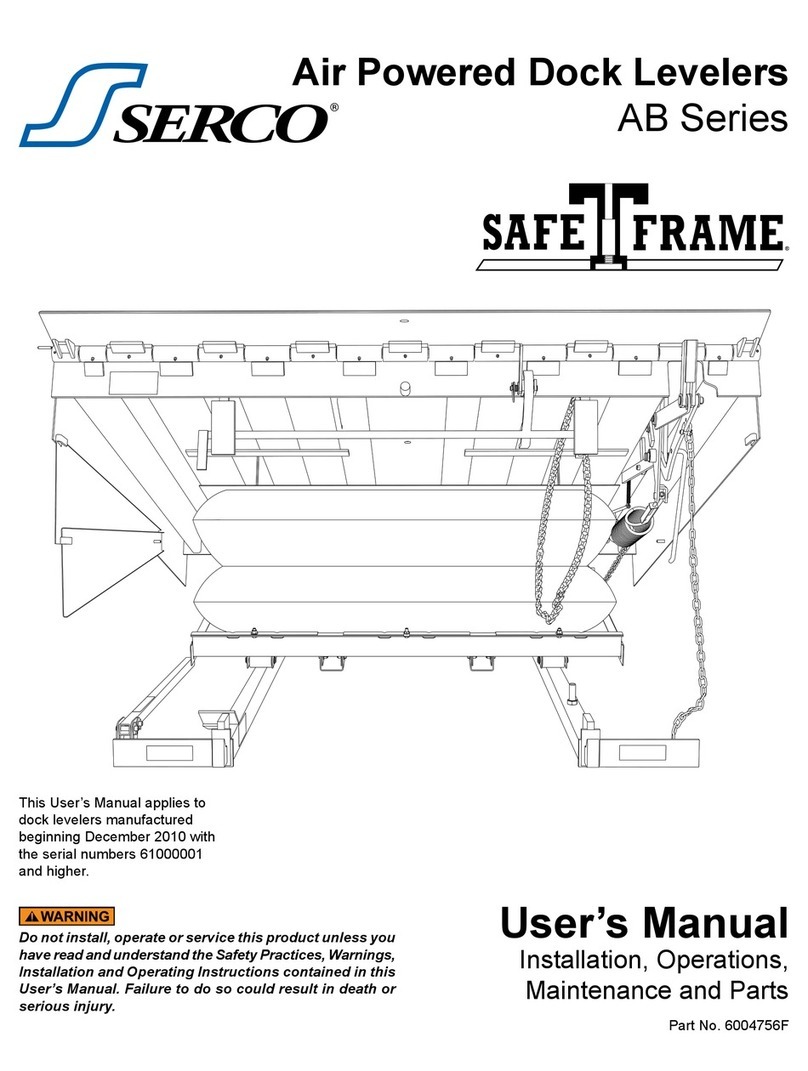
Serco
Serco SafeTFrame AB Series user manual

Nussbaum
Nussbaum TOP LIFT TSK 12000 DJ Operating manual, Inspection book
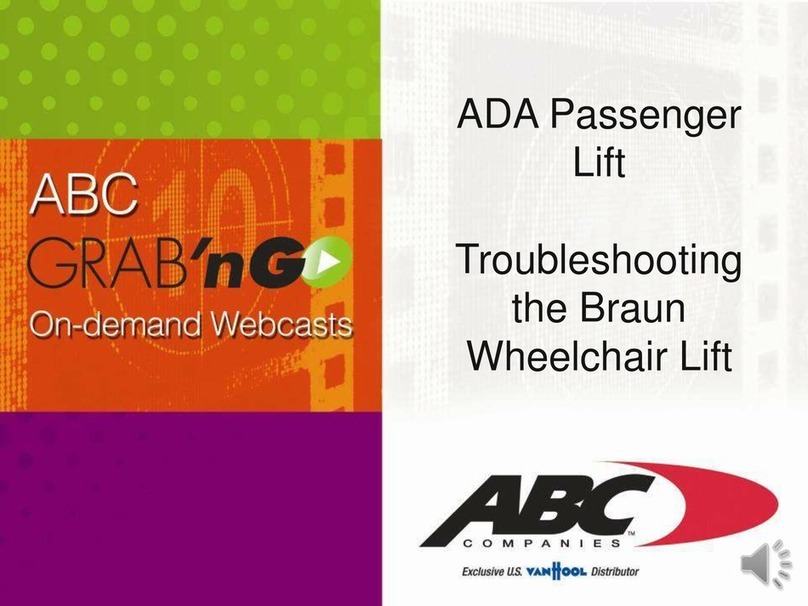
abc
abc Braun NL501 Series Troubleshooting

Haulotte
Haulotte HA16PX Technical training
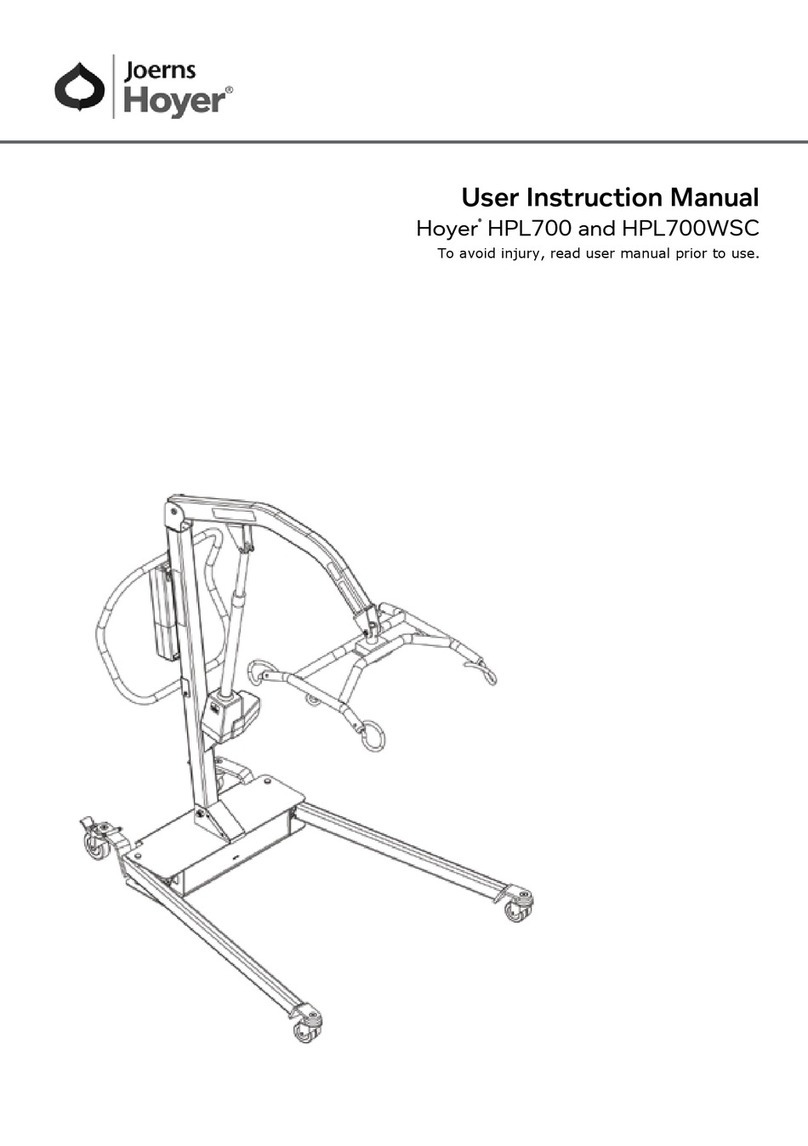
Joerns
Joerns Hoyer HPL700WSC User instruction manual
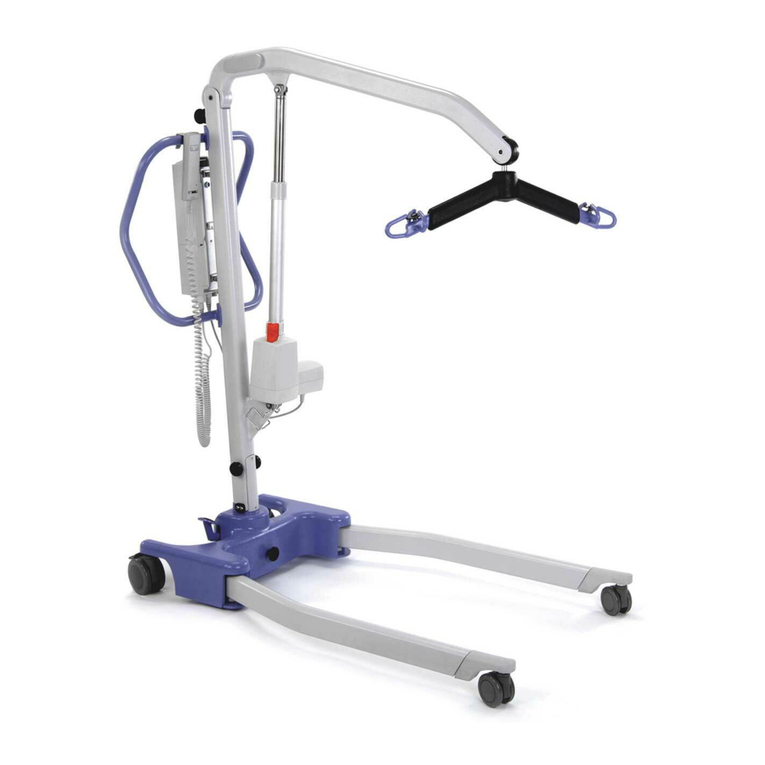
Joerns
Joerns Oxford Advance User instruction manual
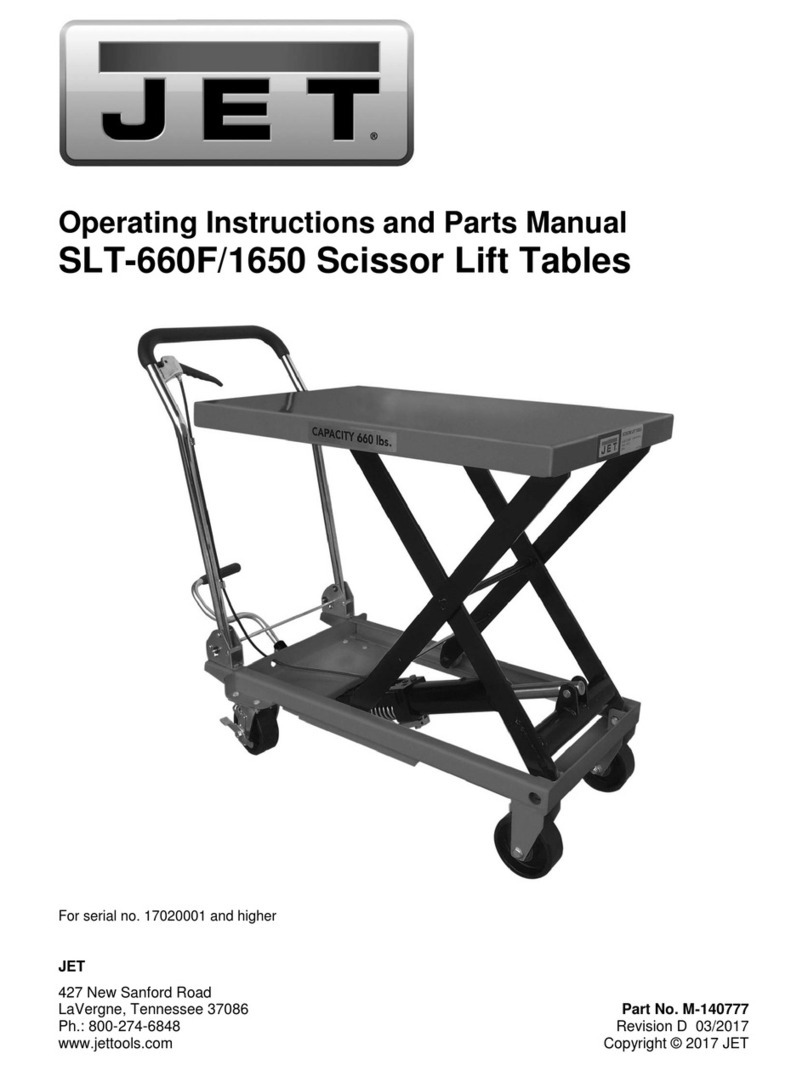
Jet
Jet SLT-660F Operating instructions and parts manual

PSS
PSS RightPath BoardWalk Assembly instructions
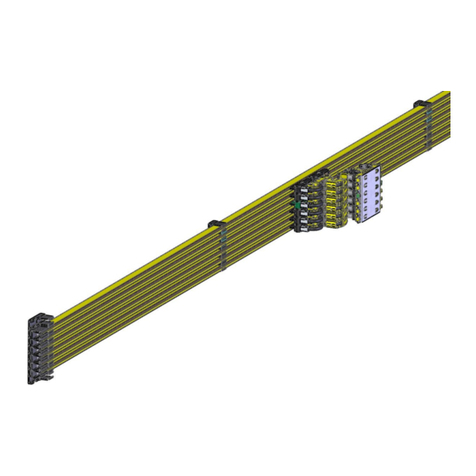
Conductix-Wampfler
Conductix-Wampfler SingleFlexLine Program 0815 operating instructions
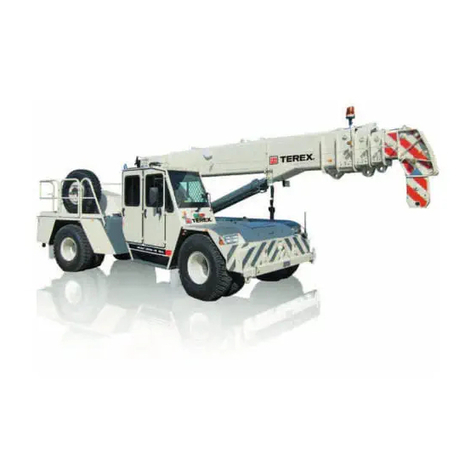
Terex
Terex MAC 25-4 SL manual
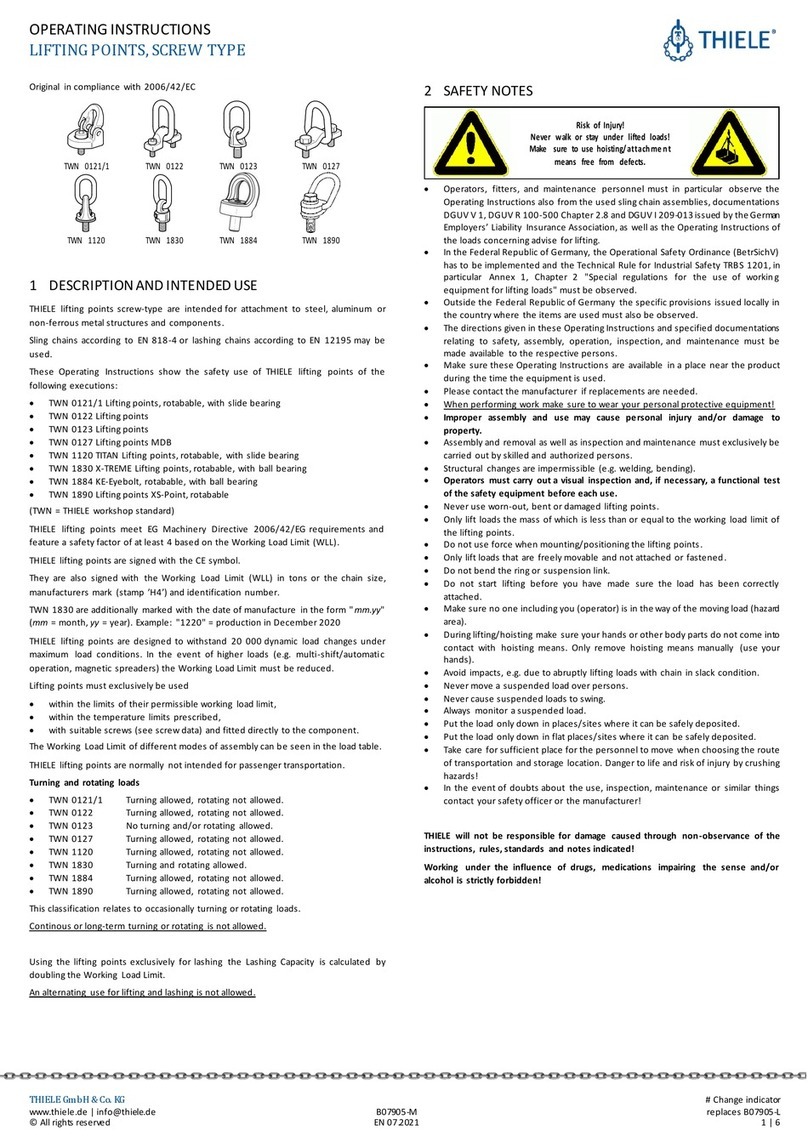
Thiele
Thiele TWN 0121/1 operating instructions
